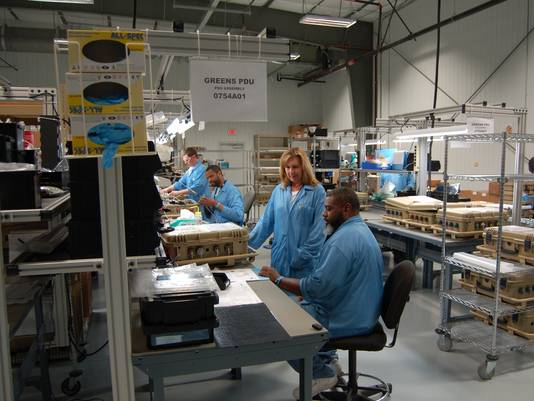
For media or press inquiries, contact:

When Rebecca Ufkes got off the phone one recent morning, an aide gave her bad news right away.
In the time it had taken her to explain how she would protect her family’s $40 million-a-year electronics-contracting firm from $1 trillion in defense-spending cuts in the next decade, UEC Electronics lost a contract to work on amphibious assault vehicles. That decision cost 19 jobs, she said.
“We were told the program was funded for two more years,” Ufkes said. “Then we were told it would be over by February.”
Things are moving that fast for smaller defense subcontractors such as UEC, and for cities such as Charleston, S.C., that depend on them. Charleston’s 250 defense contractors get most of their work from subcontracts, in fields such as electronics and computer programming, and generate up to 10% of the metropolitan economy. Thanks to the shorter contracts common for Pentagon subcontractors and information-technology vendors, the smaller fry among both companies and cities are more exposed to the cuts.
That’s why Charleston is an example of how the nation may cope with cuts that the aerospace industry claims would cost at least a million jobs as soon as this year. Spending is set to be cut $55 billion a year immediately, on top of long-term cuts passed as part of the 2011 bill to raise the federal debt ceiling.
The area’s officials and its companies have strikingly similar plans: Both are working to boost exports, find civilian tasks for their workers, and identify pockets of military spending likely to survive — especially work that there is a specific reason to do in Charleston., a metro area that gets nearly 10% of its economy from military contracts.
Charleston has embraced a local-government role in economic planning out of necessity, said Hank Taylor, a retired Air Force general who is vice president of the public-private Charleston Regional Development Alliance. Its plan relies on Obama administration policies that are unpopular in the Palmetto State, including the 2009 stimulus that helped pay for a wind-power research center.
The reason is simple: After the Cold War, Charleston lost a naval shipyard, helping boost local unemployment to 7.1% from 2.6% between 1990 and 1993. With at least 10% of the region’s 330,000 workers still depending on the military, that’s too much exposure to ignore, even with area joblessness a relatively low 6.3%, Taylor says.
A 25% spending cut, which is possible if Congress lets the full 10 years and $1 trillion-plus in defense cuts to take effect, could cost the area 3,000 to 4,000 jobs, North Charleston Mayor Keith Summey said.
“The base closing was the genesis of this agency,” said CRDA’s Taylor. “People knew we have to get diversified.”
Charleston wants to build a next-generation economy around assets it already has, building up strengths in aerospace, information technology and computer security, clean energy and biomedicine, Taylor said.
The most important part of the plan may be Boeing’s Dreamliner assembly plant in North Charleston. The factory, which began commercial production last year before regulators grounded the plane to investigate battery fires, has 6,000 employees and is already the third-biggest employer in town. Boeing said last week it will double Dreamliner production to 10 a month by the end of this year.
Companies such as UEC will latch on to Boeing, Taylor says. For Ufkes, a pending deal to make Dreamliner parts on a trial basis fits her plan to cut Pentagon-related sales to half of her 200-worker firm’s revenue, from two-thirds.
“We’re two minutes from their facility, and we have all the technology they need,” said Ufkes.
Charleston also plans to build around the Navy’s Space and Naval Warfare Systems Command, or Spawar, headquartered at Joint Base Charleston, whose mission is helping U.S. warriors maintain “information dominance,” Taylor said.
The other two cornerstones of Charleston’s plan are health care and alternative energy. The city is marketing itself to biotech firms, using the Medical University of South Carolina as a lure, and hoping Clemson University’s wind turbine testing facility will help build a renewable-energy base.
Contractors are buying in – and looking for more options themselves.
Take Geocent, a systems integrator. It does work for Spawar, and opened a Charleston office in 2010 in part to be near its headquarters, executive director Ryan Lemire said. But since 2011’s debt-ceiling showdown, Louisiana-based Geocent has moved to cut its 85% reliance on the government. It’s boosting research and development spending to develop software products, and targeting private customers for its services, Lemire said.
“If we can do health care apps for the Veterans Administration, we can target community hospitals,” he said.
The outlook for Charleston is pretty good, said Steve Cochrane, director of regional economics at Moody’s Analytics. The firm ranks Charleston’s economic vitality in the top 15% of U.S. metropolitan areas, thanks largely to Boeing and a port bolstered by BMW, which makes sport-utility vehicles for worldwide markets in Spartanburg, S.C., he added. Tourism gains in an improving economy will help offset cuts, he said.
But the transition will still be bumpy for small contractors, Ufkes said.
“I’m 80% sure we can survive,” she said. “I’m very concerned about continued growth in defense. It’s just getting worse.”
[email protected] or call us at +1 843.767.9300